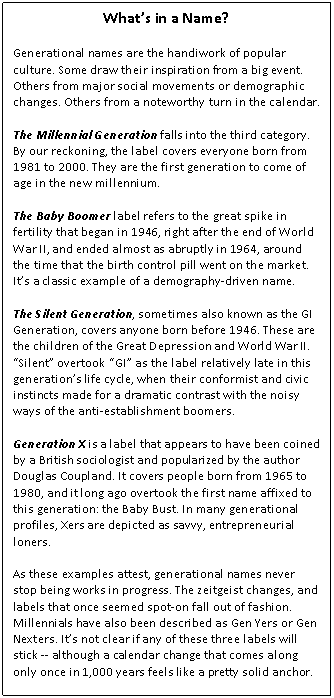by Scott Keeter and Paul Taylor
Generations, like people, have personalities. Their collective identities typically begin to reveal themselves when their oldest members move into their teens and twenties and begin to act upon their values, attitudes and worldviews.
America’s newest generation, the Millennials,1 is in the middle of this coming-of-age phase of its life cycle. Its oldest members are approaching age 30; its youngest are approaching adolescence.
Who are they? How are they different from — and similar to — their parents? How is their moment in history shaping them? And how might they, in turn, reshape America in the decades ahead?
The Pew Research Center will try to answer these questions through a yearlong series of original reports that explore the behaviors, values and opinions of today’s teens and twenty-somethings.
Even without further research, we already know a few big things about the Millennials.
- They are the most ethnically and racially diverse cohort of youth in the nation’s history. Among those ages 13 to 29: 18.5% are Hispanic; 14.2% are black; 4.3% are Asian; 3.2% are mixed race or other; and 59.8%, a record low, are white.
- They are starting out as the most politically progressive age group in modern history. In the 2008 election, Millennials voted for Barack Obama over John McCain by 66%-32%, while adults ages 30 and over split their votes 50%-49%. In the four decades since the development of Election Day exit polling, this is the largest gap ever seen in a presidential election between the votes of those under and over age 30.
- They are the first generation in human history who regard behaviors like tweeting and texting, along with websites like Facebook, YouTube, Google and Wikipedia, not as astonishing innovations of the digital era, but as everyday parts of their social lives and their search for understanding.
- They are the least religiously observant youths since survey research began charting religious behavior.
- They are more inclined toward trust in institutions than were either of their two predecessor generations — Gen Xers (who are now ages 30 to 45) and Baby Boomers (now ages 46 to 64) when they were coming of age.

Throughout 2010, the Pew Research Center will use a series of new nationwide surveys, supplemented by our analysis of government demographic economic and education data, to probe more deeply into these and other Millennial personality traits. We will compare their behaviors and attitudes with those of today’s older adults. And to the extent that we can, we will also compare them with older adults back when they were the age that Millennials are now.
We’ll also take a close look at diversity among the Millennials themselves. Generations may have personalities, but they are not monolithic. We will explore how the core values and behaviors of members of this generation differ by race, ethnicity, class, gender, ideology, partisanship, geography and religiosity.
As we launch this exercise in generational profiling, we offer one overarching note of caution. Generational differences can be the product of three different but overlapping processes, and it is often difficult to disentangle each from the others.
One is the life cycle effect. The biological impact of aging and the changing roles that people play as they grow older typically produce changes in attitudes and social behaviors over time. In short, young people may be different from older people today, but they may well become more like them tomorrow, once they themselves age.
The second is the cohort effect. Generation differences can be the byproduct of the unique historical circumstances that members of an age cohort experience during adolescence and young adulthood, when awareness of the wider world deepens and personal identities and values systems are being strongly shaped. The unique nature of the times imprints itself on each successive age cohort, producing differences that persist even as a cohort ages and moves through the life cycle.
In addition to life cycle and cohort effects, there are also period effects. These are major events (wars, social movements, scientific or technological breakthroughs) that are likely to have a simultaneous impact on all age groups, though, again, their impact is often greatest among the young because their values and habits are less fixed than those of other age groups.
The most common approach to trying to understand how each of these processes plays out is through cohort analysis, which uses data collected at different times to track changes in the attitudes and behavior of cohorts as they age.
Most cohort analysis does not involve interviews with the same individuals at multiple points in time. Instead, separate samples of each cohort are compared over time. For instance, the attitudes of survey respondents who were ages 20-29 in 1990 can be compared with those of respondents ages 30-39 in 2000 and ages 40-49 in 2010. All three samples are part of the same cohort, and taken together these three snapshots produce a moving picture showing how a specific generation ages. At the same time, each snapshot can also be compared with contemporaneous snapshots of other age cohorts, allowing for evaluations of whether different generations are aging in different ways.
An example based on a survey question about attitudes toward interracial dating helps illustrate the way these processes and analyses overlap.
Since 1987, the percentage of Americans approving of interracial dating has increased dramatically, from 48% to 83%. A cohort analysis shows that this change has occurred partly as a result of nearly all individuals become more accepting over time of blacks and whites dating, and partly through generational change, as each new cohort has come of age more supportive than older cohorts.

The graph shows the percentage approving of interracial dating for each of four cohorts (or generations), tracking their responses across the 13 separate waves of polling between 1987 and 2009. Several things are evident from the graph. One is that there is an upward trend in acceptance of interracial dating in most cohorts as time passes. For instance, just 36% of the “Silent” generation (born before 1946) approved in the first interviews in 1987, but by 2009, 67% of members of this cohort approved.
Another conclusion from the graph is that each younger cohort is more supportive than the cohorts that preceded it. Baby Boomers were more supportive in 1987 than members of the Silent Generation, and remained that way throughout. Generation X (at 82%) was more supportive than the Baby Boomers when it first appeared in the surveys. And the Millennial cohort is the most supportive of all.
The pattern suggests a strong period effect in the direction of greater acceptance of interracial dating. This changing climate for race relations means that each new cohort came to adulthood more supportive of interracial dating, but the continuing cultural forces also persuaded some individuals to change their views on this topic at some point during adulthood. It is also possible that the growing racial and ethnic diversity of the U.S. population over this period contributes to the trend, since blacks and Hispanics are more supportive of interracial dating than are whites.
Whenever we can, the Pew Research Center will undertake this sort of cohort analysis. Unfortunately, for many measures of the public’s attitudes and behaviors, long-term trends of the type shown here for interracial dating attitudes do not exist. Consequently, the best available evidence for detecting many generational differences are comparisons of attitudes and behaviors across age groups from a single point in time, or, at best, over a relatively short period of time.
Even so, we believe our series of reports will help to illuminate the lives and times not just of Millennials, but of all Americans.
Scott Keeter is the director of survey research and Paul Taylor the executive vice president of the Pew Research Center.
1. Among the first to use this term were William Strauss and Neil Howe, whose 1991 book, Generations: The History of America’s Future, 1584 to 2069, was widely recognized for its contribution to the analysis of cohort differences in U.S. history and their potential impact on the future. In Millennials Rising: The Next Great Generation, published in 2000, Strauss and Howe focused on those born in or after 1982.





